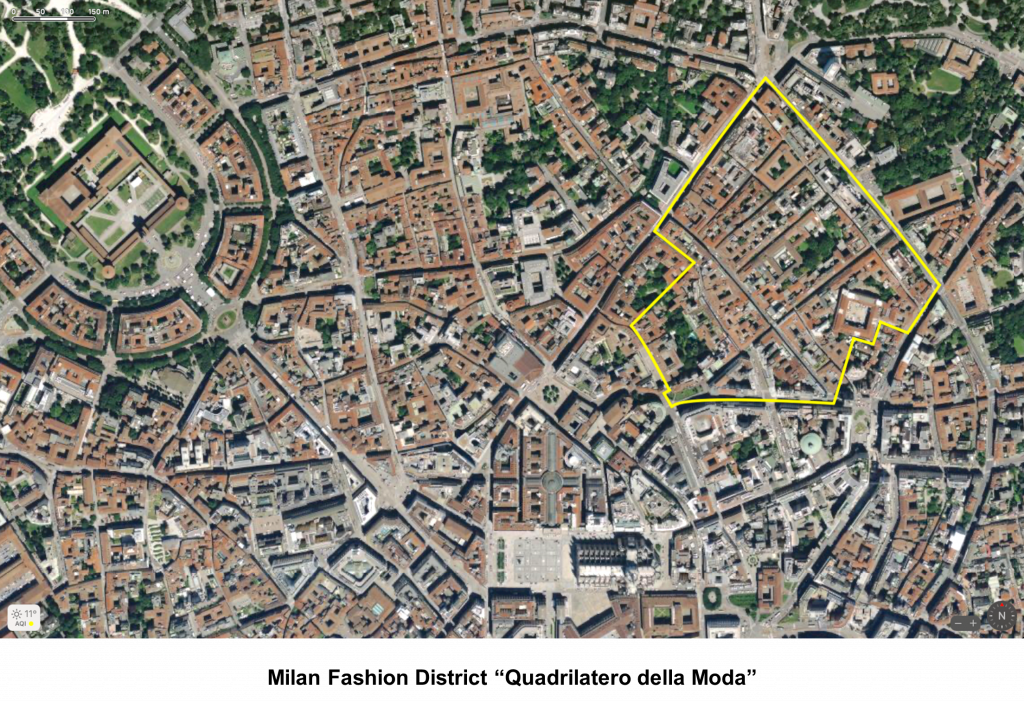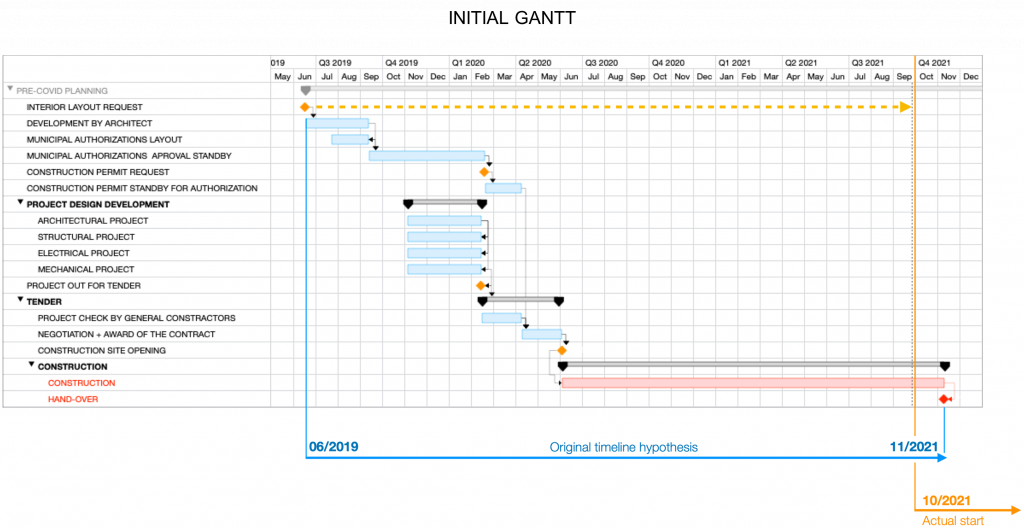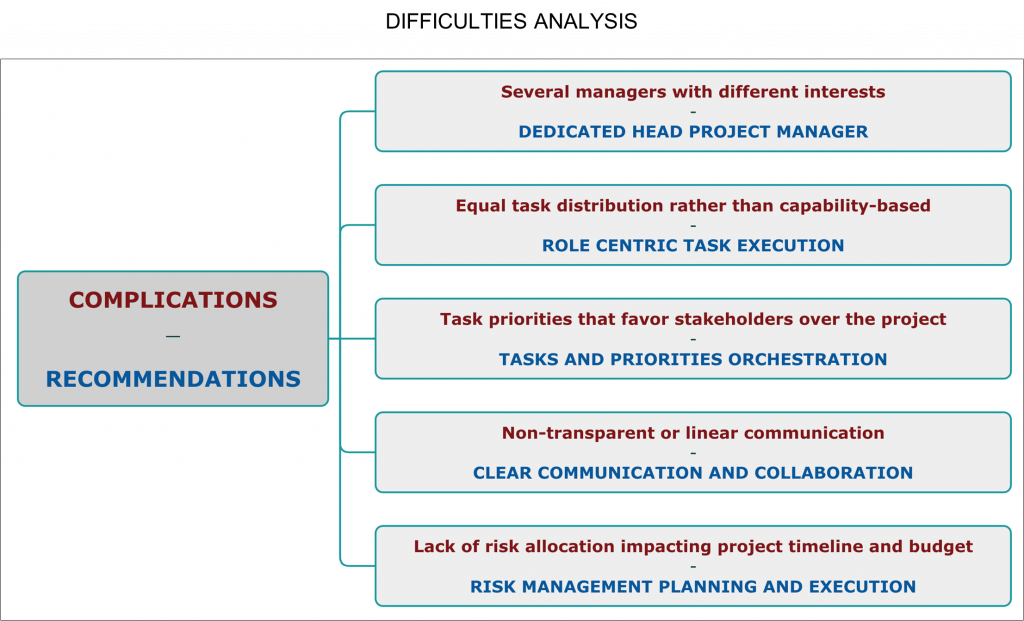AUTORE: arch. Andrea Carolina Gruber Figarelli
TUTOR: ing. Giovanni Franchi
MASTER: Project and Contract Management in Construction Works 2022-2023
I progetti di ristrutturazione nel settore del lusso di alta gamma comportano considerevoli rischi, coinvolgono molteplici attori e dinamiche complesse, e una notevole quantità di sfide da affrontare, tutti aspetti circoscritti nella loro natura. Il risultato finale deve essere di altissima qualità, caratterizzato da una produzione impeccabile e finiture perfette, estremamente creativo e al passo con le innovazioni tecnologiche. Ma soprattutto, deve offrire un’esperienza eccezionale che faccia innamorare il cliente del brand. Questa tesi esplora le sfumature di un progetto di ristrutturazione di un negozio di alta gamma a Milano, analizzando l’insieme delle sfide affrontate.
Questo progetto non ha seguito uno script tradizionale. Al contrario, si è avventurato in territori inaspettati e ha dovuto affrontare principalmente un evento unico nel suo genere: la pandemia di COVID-19, che ha interrotto bruscamente la sua linea temporale senza indicazioni di ripresa. Gli effetti di questa pandemia sono durati a lungo e i vari fornitori stanno ancora affrontando ritardi negli ordini e nella ricerca di prodotti che rendono difficile la conclusione del loro lavoro.
Questa pandemia ha lasciato il progetto in uno stato di notevole frammentazione, solo per essere riattivato anni dopo, proprio nel momento programmato per l’inizio della sua costruzione. Purtroppo, un progetto incompleto come questo costituisce una minaccia diretta per la corretta realizzazione e gestione. Tutti gli effetti negativi derivanti da questa situazione hanno colpito il suo sviluppo, inclusi ritardi causati da modifiche, costi aggiuntivi, una costruzione non lineare e, soprattutto, una significativa confusione tra gli stakeholder e le responsabilità corrispondenti. Le gerarchie stabilite e le linee di comunicazione sono state costantemente stravolte e riorganizzate quotidianamente, in base ad esigenze specifiche e priorità non chiare. Di conseguenza, questo ha portato a disinformazione e dubbi all’interno di ciascun team, creando una mancanza di controllo e direzione, in particolare per quanto riguarda la gestione del cantiere.
Infine, la complicazione più incisiva si è manifestata durante la fase di costruzione, quando il progetto ha subito una deviazione importante. Il progresso del cantiere è stato interrotto, e il design è stato ripensato in corso d’opera, cercando nel frattempo di raccogliere informazioni da varie fonti per poter ottenere una visione complessiva del nuovo risultato desiderato. La complessità delle sfide si è moltiplicata, trasformando ogni dettaglio in un notevole dilemma e rendendo anche la più semplice delle “complicazioni” un nuovo ostacolo da affrontare.
Tutte le difficoltà durante questo progetto hanno avuto effetti significativi sulle dinamiche di gestione, che sono state ridefinite durante il corso della ristrutturazione, evidenziando un chiaro deficit di definizione nei ruoli e nelle responsabilità tra i vari partecipanti. Nonostante ogni squadra avesse il suo leader, si è notata una mancanza critica sotto forma di un project manager dedicato che sovrintendesse l’intera operazione. Questo ruolo avrebbe svolto un compito fondamentale nella gestione delle informazioni, nell’istituzione di obiettivi per monitorare il progresso complessivo e nell’assicurare una comunicazione efficace tra tutte le parti coinvolte. L’assenza di questa figura ha portato a problemi di disinformazione, cattiva gestione delle risorse e sovrapposizioni di compiti, con conseguenti ritardi. L’introduzione di un project manager dedicato avrebbe rappresentato un’autorità imparziale, interamente dedicata al successo del progetto. Questa aggiunta strategica avrebbe contribuito a garantire canali di comunicazione chiari, il rispetto delle gerarchie, direttive esplicite e, soprattutto, avrebbe agevolato l’intera operazione del cantiere senza interruzioni.
Allo stesso tempo, la comunicazione e la collaborazione hanno sofferto di carenze significative in ogni fase del progetto, e questa mancanza è emersa principalmente durante la conclusione di ogni fase (es. collaudo impianti/elettrico e chiusura architettonica) del progetto. Questi aspetti si possono considerare la colla che tiene insieme qualsiasi progetto fin dall’inizio.
Le numerose raccomandazioni derivate da questo studio, ed emerse dai principali problemi che sono stati affrontati, sono strumenti che avrebbero potuto agevolare la navigazione del progetto. Certamente, queste raccomandazioni servono come best practices da considerare nell’implementazione di progetti complessi con relazioni intricate tra gli stakeholder, dove gli standard lavorativi non vengono rispettati in modo tradizionale. Gli strumenti fondamentali della gestione esistono per sostenere sia il progetto che il project manager fino alla fine.
Questo studio sottolinea l’importanza della gestione efficace e dell’utilizzo di tutti gli strumenti a disposizione che portano ad un risultato con successo rispettando la timeline generale, il controllo del budget, la gestione del tempo e la distribuzione delle risorse. La tesi evidenzia soprattutto quanto sia cruciale la coesione dei gruppi e il valore della collaborazione tra tutte le parti coinvolte per ottenere il massimo risultato possibile nel completamento del progetto.
FOR INTERNATIONAL STUDENTS
High-end luxury retail projects entail significant stakes, involving multiple complex dynamics, numerous stakeholders, and countless challenges to overcome: all aspects part of their nature. The final result must be of the utmost quality, with high manufacturing and perfect finishings, not to mention greatly creative as well as technologically innovative. Most importantly, the outcome must provide an exceptional experience that makes the client fall in love with the brand. This thesis delves into the intricacies of a high-end store refurbishment project in Milan exploring the unique set of challenges it faced.
This project didn’t follow the traditional script. Instead, it veered into unforeseen territory, including a once-in-a-lifetime event – the COVID-19 pandemic, which essentially hit the ‘pause’ button on the project’s timeline without a clear endpoint. The effects of this pandemic were long-lasting and the various suppliers are still running into order delays and product hunts that make the completion of their work difficult to achieve due to COVID-related collateral issues.
This pandemic left the project in a severe state of fragmentation, only to be reactivated years later at the same time as its intended construction. Unfortunately, an unfinished project at the time of its execution represents a direct menace toward its correct realization and management. All that can be derived from this handicap was suffered during its timeline, such as delays, budget extras, non-linear construction, and most importantly, severe confusion amongst stakeholders regarding their tasks.
Established hierarchies and lines of communication were being constantly overturned and re-arranged on a daily basis, according to specific needs and unclear priorities. As a result, this led to misinformation and doubts within each team, creating a lack of control and direction, particularly regarding the management of the construction site, the project’s execution timeline, and the budget.
Lastly, the most disruptive complication emerged during the construction phase when the project suffered a complete deviation. The progress of the site was paused, and the design was re-established on the spot during construction with an unclear project, while at the same time, trying to acquire information from distinct sources in order to get a general picture of the new desired outcome. The complexity of the stakes was unnecessarily augmented turning each detail into the size of an enterprise and making even the simplest of “complications” a new obstacle that had to be overcome.
All the complications during this project had important effects on the management dynamics that were reinvented during the timeline of this refurbishment, revealing a pronounced lack of clarity in roles and responsibilities among the diverse stakeholders. While individual teams had their respective leaders, a critical absence was evident in the form of a dedicated project manager overseeing the entire operation. This manager would have been instrumental in handling information, establishing milestones for tracking overall progress, and ensuring effective communication among all parties involved. The absence of such an important role led to miscommunication, resource mismanagement, and task overlaps. The introduction of a dedicated project manager would have served as an impartial authority, singularly committed to the project’s success. This strategic addition could have helped secure clear communication channels, upheld hierarchies, provided explicit directives, and, most importantly, facilitated uninterrupted execution.
Clear communication and collaboration are two aspects that suffered important deficiencies during each phase of the project, and the lack of it comes up while drawing the final conclusions and doing the final tests. It becomes extremely clear how this very aspect could be considered the glue that holds any project together from its inception, through the execution, and right up to the final handover.
The numerous practical recommendations derived from this case study are tools that could have helped during the navigation of this specific project and that resulted from the main issues that had to be endured, however, they certainly serve as future practices worth considering implementing in intricate projects with multifaceted stakeholder relationships where work standards are not met for a variety of reasons. Even though no project is the same, the tools that compose the foundation of project management exist to help both the project and the manager towards the desired result.
This study emphasizes the importance of effective management and the use of all available tools to achieve a successful outcome, respecting the overall timeline, budget control, time management, and resource distribution. It also particularly accentuates the importance of consolidated teams and the significance of collaborative work between all stakeholders in order to get to the final goal: the completion of the project with the best possible outcome.



